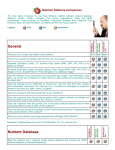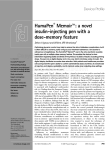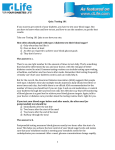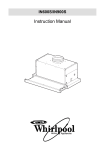Download GlucoMenu
Transcript
______________________ ® GlucoMenu User Manual Contents Introduction from Christine…………………………………………………… 2 Getting started………………………………………………………………… 3 Program features……………………………………………………………… Menus, recipes, grocery lists, nutrition facts Calorie levels & how to adjust Substitution list 4 Nutrition Facts & basis for the menus………………………………………… Calories Carbohydrate Fiber Fat Protein Sodium 5 Exercise……………………………………………………………………….. Exercise recommendations (frequency & duration) Benefits of exercise (increased insulin sensitivity) Getting started with exercise Avoiding common pitfalls (no pain no gain) Sample beginners walking program 6 Weight Loss…………………………………………………………………… 3500 calories = one pound 1-2 pounds per week Body Calculator 9 Blood sugar recommendations………………………………………………... 10 Glossary……………………………………………………………………….. 11 (c) 2011 www.GlucoMenu.com 1 Introduction from Christine The basic idea behind GlucoMenu® is to provide an easy to follow program with lots of variety using common foods found at any major grocery store. Since we provide a new menu for every day of the week you should have no trouble finding something to your liking. In the event you don’t like a particular day of menus (or don’t have the food item in your pantry) simply select from another day and repeat that day of menus until you are ready for something new. GlucoMenu® embraces the recommendations of the American Diabetes Association and the American Heart Association. Careful consideration has been made in creating the Nutrition Facts section. You will notice our menus are higher in fiber, lower in fat, with carbohydrate evenly distributed throughout the day. It is my sincere hope that our program helps you to achieve your health goals. Although no one aspect of diabetes management is a “silver bullet”, studies have shown that diabetes related complications can be minimized when a healthy lifestyle is adopted. A healthy lifestyle includes a balanced diet and regular exercise over the long term. I find I get a lot more out of life when I am eating right and exercising on a regular basis. I hope the same holds true for you. Christine Carlson, MS, RD, BC-ADM, CDE GlucoMenu® Nutrition Director *Christine is a Registered Dietitian & Certified Diabetes Educator. Christine also serves on the Diabetes Panel of Experts for Diabetes Monitor. Her professional memberships include: American Association of Diabetes Educators American Diabetes Association American Dietetic Association (c) 2011 www.GlucoMenu.com 2 Getting started with GlucoMenu® You do not have to follow every single day of menus to see results with the program. In the beginning you may want to pick a couple of days of menus to your liking and repeat those days until you are ready for more variety. If you are on a tight budget this approach will help you utilize the food you already have on hand while minimizing costs. Once you login to the GlucoMenu.com website you will be presented with the two weeks of menus, recipes, grocery lists, and nutrition facts. You should print these items. Notice the Substitution link at the top of the page. In the event you are allergic or dislike a food you can use the Substitution List. Simply locate the food you wish to replace and substitute with a like item. Every Monday GlucoMenu® displays a new week of menus (so be sure and login sometime during the week to get your new menus). (c) 2011 www.GlucoMenu.com 3 Program Features Once you login to the GlucoMenu® website you will be presented with two weeks of menus, recipes, grocery lists, and nutrition facts. You should print these items for future use. Menus You will find that the menus are seasonal and consider holidays. We include grilled items and salads in the summer months and more soups & casseroles during the winter months. The * (asterick) symbol next to a menu item indicates this is one of the three highlighted recipes for the week. Detailed recipe information is available from the recipe link (directly below the menu links once you login). Recipes Every week GlucoMenu® features three recipes and incorporates them into the menus. All of the ingredients for these recipes are included in the Grocery List for the week. Grocery List The Grocery List we provide is comprehensive and includes everything you would require if you were to follow our menus strictly. Be sure to mark off items you already have in your kitchen so that you do not have to spend extra at the supermarket. Some items will reappear on the menu each week. Items like skinless chicken breasts and wheat bread can be frozen and used week to week. Other items such as cereal, brown rice, and crackers can be kept on hand in your cabinet for use week to week. Take advantage of your bulk section in the grocery store to purchase only what you need. Nutrition Facts Nutritional information for every meal & snack on the menu can be located via the Nutrition Facts link (directly below the Grocery List). We provide total calories, carbohydrate, fiber, fat, protein, and sodium for the day as well as for each meal & snack. You can find more detailed Nutrition Facts information in the next section of this manual. Calorie Level There are five calorie levels available: 1200, 1500, 1800, 2100, & 2400. Calorie level can be changed at anytime by visiting the “My Info” link once you login. You can confirm your current calorie level by visiting the Nutrition Facts and My Info links. Substitution List A Substitution List link is available once you login to the program. This list is very helpful for those with food allergies. It also comes in handy if you have a food dislike or would like to use something you have on hand. If you are allergic to a food or dislike a food you will need to use the substitution list to replace that food on the menu. To use the Substitution List simply located the food you wish to replace and substitute with a like food. (c) 2011 www.GlucoMenu.com 4 Nutrition Facts While there is no one diabetic diet, we try to offer healthy menus embracing the recommendations of the American Diabetes Association. We focus on a variety of grains, fruits, vegetables, low fat dairy products, lean meats and other protein sources, and healthier fats. Our menus average about 50% from carbohydrate (evenly distributed throughout the day), less than 30% fat, less than 10% saturated fat, and less than 300 mg of cholesterol. The remainder of the calories are derived from protein. Calories Menus are based on calorie level. We provide total daily calories as well as calories for each meal and snack. Carbohydrate Carbohydrate is evenly distributed throughout the day in our menus. We focus on nutrient dense carbohydrates providing additional vitamins, minerals, and fiber. The RDA for carbohydrate has been set at 130 grams per day for children and adults. The brain alone uses an average minimum of 130 grams carbohydrate daily. This minimal amount is where the RDA is derived. Consider that other parts of the body would like to use carbohydrate for energy as well. Fiber You will find our menus include higher fiber products such as brown rice, whole fruits and vegetables, whole grain bread, and high fiber tortillas. The American Dietetic Association recommends 20-35 grams of fiber per day. Fiber is a type of carbohydrate found in fruits, vegetables, and grains. The benefits of eating a diet rich in fiber include: aids in weight loss, can help reduce blood cholesterol, can help delay sugar into the bloodstream, and may alleviate constipation. Fat Our menus average less than 30% calories from total fat and less than 10% calories from saturated fat. You will find that our menus focus on healthier fats including olive oil, canola oil, and nuts. Protein We strive to include lean choices of protein to reduce fat in the menus. In the event that you have kidney issues you should speak with your doctor about how much protein is appropriate. Sodium We embrace the American Diabetes Association guidelines for sodium. You will find our menus call for reduced sodium products. (c) 2011 www.GlucoMenu.com 5 Exercise Ideally you should be exercising at a moderate intensity for 30-45 minutes five days a week. The American Diabetes Association recommends exercising on most if not all days of the week and suggests no more than 2 days off between exercise sessions. Benefits of exercise Those with diabetes often see improved glucose tolerance and insulin sensitivity from exercise. Exercise increases calories burned which helps to reduce body weight too. For some this may mean taking less medication. Those with diabetes are at increased risk for heart disease (#1 cause of death in the United States). Exercise reduces risk for heart disease by strengthening the heart. The heart is a muscle and can be conditioned with exercise. Exercise helps reduce resting heart rate. Exercise also aids in reducing blood pressure. Finally, exercise helps to increase the "good cholesterol" (HDL cholesterol). HDL cholesterol carries cholesterol out of the body instead of depositing it in the arteries or tissues. Getting started with exercise If you haven’t exercised in a long time (true for many) you will want to be sure and slowly workup to the above recommendations. One suggestion for beginners is to add 1 minute every day to your exercise routine. Be sure to speak with your doctor about any exercise regime you are considering. Avoid painful activities "No pain, no gain?" Physical activity should not be painful. Gradually increase exercise intensity and duration with each workout. Avoid the common mistake of jumping into exercise only to pull a muscle, strain a knee, or twist an ankle. Exercise daily to benefit your health not hamper it with an injury. Types of exercise The key to being consistent with exercise over the long run is to find something you enjoy. Choose a physical activity that you can easily fit into your lifestyle. If going to the gym every day is not realistic with your schedule/location then try waking up a little earlier and going for a brisk walk. If you have a lunch hour at work go for a walk after you eat. Making exercise easier It takes some effort and dedication to exercise every day, however the benefits are worth it. Listening to music makes exercise easier! Use a music device with headphones (MP3, CD, or tape player) to keep you moving. Choose your favorite upbeat music to stay motivated during a workout. (c) 2011 www.GlucoMenu.com 6 Proper attire Minimize impact on joints with shoes designed for your exercise/activity. If you walk for exercise, purchase walking shoes (and if you jog or run purchase running shoes). Shoes designed for a specific activity can help prevent injury to joints and reduce foot, ankle, and knee stress. Replace running and walking shoes every three months. *Tennis shoes & cross-trainer shoes are not the same as running shoes and walking shoes. Gyms & exercise classes Consider joining a gym or health club. Becoming a gym member can help you exercise consistently, especially on the days where outdoor activity is not an option due to weather. Ask your local health club for a free 2-week pass to evaluate whether it is a fit for you. Health club staff should be able to introduce you to the equipment (how to use it) and other benefits of the facility. Joining an exercise class can help keep you motivated and consistent with your workouts because they are offered at set times. Make sure the difficulty level meets your fitness ability and determine if the instructor is certified to teach exercise classes. Exercise should always include a warm up, heart rate monitoring, and a cool down period with stretching. (c) 2011 www.GlucoMenu.com 7 Sample walking program for beginners The Walk - Walking can be broken down into 3 parts: warm up, brisk or fast walk, and cool down. 1. Warm up - this is a slow walk at the beginning of your workout. The warm up lasts 5 minutes. 2. Brisk walk - increase your pace for this portion of the walk. This will be the main portion of your workout. The primary goal is to build up to 30 minutes of brisk walking 5 times a week. 3. Cool down - this is a slow walk at the end of your workout to slowly bring your heart rate and breathing back to normal. The cool down lasts 5 minutes. BUILD UP TO 30 MINUTES BRISK WALKING FIVE DAYS A WEEK WARM UP TIME FAST WALK TIME COOL DOWN TIME TOTAL TIME WEEK 1 walk slowly 5 min. walk briskly 5 min. walk slowly 5 min. 15 min. WEEK 2 walk slowly 5 min. walk briskly 8 min. walk slowly 5 min. 18 min. WEEK 3 walk slowly 5 min. walk briskly 11 min. walk slowly 5 min. 21 min. WEEK 4 walk slowly 5 min. walk briskly 14 min. walk slowly 5 min. 24 min. WEEK 5 walk slowly 5 min. walk briskly 17 min. walk slowly 5 min. 27 min. WEEK 6 walk slowly 5 min. walk briskly 20 min. walk slowly 5 min. 30 min. WEEK 7 walk slowly 5 min. walk briskly 23 min. walk slowly 5 min. 33 min. WEEK 8 walk slowly 5 min. walk briskly 26 min. walk slowly 5 min. 36 min. WEEK 9+ walk slowly 5 min. walk briskly 30 min. walk slowly 5 min. 40 min (c) 2011 www.GlucoMenu.com 8 Weight Loss Weight loss and weight gain are affected by: 1. Food Consumption (calories consumed) 2. Energy Expended (activity such as exercise) One pound of body weight is equal to 3500 calories. Lose 1 pound of weight each week by reducing food consumed daily by 250 calories and increasing energy expended by 250 calories for a total daily calorie deficit of 500. Five hundred calories per day x 7 days per week = 3500 calories, or one pound weight loss per week. The goal of long term weight loss is best accomplished by adopting eating and exercise habits that you will stick with every day. Gaining weight doesn't occur overnight and neither does losing it. Do not become discouraged, stay focused on your goal and know that it takes time. When weight loss occurs, you will be able to move better, breathe better, and resting heart rate will decrease making exercise a bit easier to accomplish each day. 1-2 pounds weight loss per week is realistic and sustainable. If you lose 1-2 pounds per week for three months that works out to be 12-24 pounds! Body Calculator: There is a Body Calculator located at http://GlucoMenu.com/Body_Calculator/ (you can also find the Body Calculator via the Links page). Use our Body Calculator to help you determine: Calories needed to maintain your current bodyweight, Body Mass Index (indicator for disease based on body weight), Ideal body weight based on height & frame size (c) 2011 www.GlucoMenu.com 9 Blood Sugar Recommendations Normalizing blood sugar is the main goal. Strive to get blood sugar close to that of a healthy person who does not have diabetes. The goal of blood sugar depends on when you are testing - before a meal (pre-prandial), after a meal (post-prandial), prior to going to bed. Each organization below provides guidelines for a variety of blood sugar testing times. The American Diabetes Association acknowledges these as normal blood sugar for healthy people who do not have diabetes: fasting/before eating < 100 mg/dl 2 hours after eating (post-prandial) <140 mg/dl A1c blood sugar test (3 month blood sugar indicator) 4-6% The American Diabetes Association recommends the following blood sugar goals for those with diabetes: before eating (pre-prandial) 70-130 mg/dl 1-2 hours after eating (peak post-prandial) <180 mg/dl A1c blood sugar test (3 month blood sugar indicator) <7% The American Association of Clinical Endocrinologists (endocrinologists are medical doctors specializing in disorders including diabetes) recommends the following blood sugar goals for those with diabetes: before eating (pre-prandial) 110 mg/dl 2 hours after eating (post-prandial) 140 mg/dl A1c blood sugar test (3 month blood sugar indicator) <6.5% Each person may have different goals for treating their diabetes. It is important to discuss blood sugar control goals with your diabetes educator or doctor so you know what to personally try to achieve. (c) 2011 www.GlucoMenu.com 10 Glossary A1c A1c test reveals what your average blood sugar has been running over the past 3 months. The American Diabetes Association (ADA) recommends striving for an A1c of less than 7% for those with diabetes. BMI Body Mass Index (BMI) is based on weight and height and used as an indicator for obesity. A healthy BMI is 18.5 to 24.9. A BMI of 25 or above is associated with heart disease, type 2 diabetes, and high blood pressure. Body Calculator There is a Body Calculator located at http://GlucoMenu.com/Body_Calculator/ (you can also find the Body Calculator via the Links page). Use our Body Calculator to help you determine: Calories needed to maintain your current bodyweight, Body Mass Index (indicator for disease based on body weight), Ideal body weight based on height & frame size Calories A calorie is a unit of energy your body uses from the food & beverages you consume. One pound of body weight is equal to 3500 calories. Excess calories that the body does not expend will be stored as fat. Carbohydrate Carbohydrate is one of the three major sources of energy (the other two being protein & fat). Types of carbohydrate include sugar, starch, and fiber. Sources of carbohydrate include fruits, vegetables, grains, and dairy products. There are 4 calories per gram of carbohydrate. Diabetes Prevention Program The Diabetes Prevention Program (DPP) found that those with Pre-Diabetes can make simple lifestyle changes to reduce risk for diabetes later in life. The DPP found that subjects with Pre-Diabetes experienced a 58% reduction of risk for Type 2 diabetes when they: lost a modest amount of weight (5-7% of their body weight), exercised at moderate intensity for an average of 30 minutes a day, five days per week (most chose to walk for exercise), and lowered their intake of fat and calories. Those following the lifestyle changes were able to reduce their risk even more so than those taking medications to lower blood sugar. These preventative measures can "turn back the clock" and return elevated blood sugar to normal levels. (c) 2011 www.GlucoMenu.com 11 Fat Fat is one of the three major sources of energy (the other two being carbohydrate & protein). Healthier types of fat include monounsaturated fats (e.g. olive oil & canola oil) and omega-3 fatty acids (e.g. seafood, walnuts, leafy greens). Fats that should be limited include saturated fats (e.g. butter & lard). Trans fats are commonly found in baked products and snack foods and should be minimized. There are 9 calories per gram of fat. Fiber Fiber is a type of carbohydrate found in fruits, vegetables, and grains. The American Dietetic Association recommends 20-35 grams of fiber per day. The average American only gets 12 grams of fiber each day. Food Picker The Food Picker application can be found at http://GlucoMenu.com/Food_Picker/ Food Picker is a tool that analyzes over 5,000 common foods, beverages, and restaurant items. It tells the end user if they should select a food, “more often”, “less often”, or “in moderation”. Pre-Diabetes Pre-Diabetes is a condition where one has fasting blood sugar levels above normal (blood sugar between 100-125 mg/dl) but the blood sugar levels are not high enough to diagnose diabetes (fasting blood sugar above 126 mg/dl). Pre-Diabetes was previously called impaired glucose tolerance or impaired fasting glucose. Those with Pre-Diabetes are at greater risk for developing Type 2 Diabetes, but there are preventative measures including weight loss, increased physical activity, and following a healthy diet (see Diabetes Prevention Program in this glossary for more details). Protein Protein is one of the three major sources of energy (the other two being carbohydrate & fat). Lean sources of protein include skinless chicken or turkey breast, fish, egg whites or egg substitute, and fat free cottage cheese. There are 4 calories per gram of protein. Sodium The American Diabetes Association recommendation for sodium is less than 2300 milligrams per day. Those with hypertension or high blood pressure may have been warned about eating too much sodium. For some, limiting sodium or salt helps control blood pressure. Sugar Alcohols Sugar alcohols are reduced calorie sugar substitutes that can be found in sugar-free candies and desserts. Sugar alcohols do not have as much effect on blood sugar in comparison to regular table sugar. (c) 2011 www.GlucoMenu.com 12 Type 1 Diabetes Type 1 Diabetes is a disorder in which the body does not produce insulin (a hormone that aids in moving sugar from the blood to the cells). This type of diabetes can be due to a virus or autoimmune disorder in which the body does not recognize an organ as its own and attacks it. In this case the body attacks an organ known as the pancreas where insulin is made. This type of diabetes is usually diagnosed before age 40. Type 2 Diabetes Type 2 Diabetes occurs when insulin that the body produces is less efficient at moving sugar out of the bloodstream. Some sugar is moved out of the blood, just not as effectively compared to a person with normal insulin efficiency. High blood sugar is a result of this. Treatment of Type 2 Diabetes includes a healthy diet, physical activity (exercise), and medication. (c) 2011 www.GlucoMenu.com 13





























